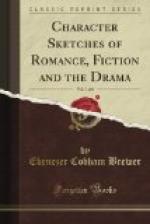Duessa, in bk. v., allegorizes Mary queen of Scots. She is arraigned by Zeal before Queen Mercilla (Elizabeth), and charged with high treason. Zeal says he shall pass by for the present “her counsels false conspired” with Blandamour (earl of Northumberland), and Paridel (earl of Westmoreland), leaders of the insurrection of 1569, as that wicked plot came to naught, and the false Duessa was now “an untitled queen.” When Zeal had finished, an old sage named the Kingdom’s Care (Lord Burghley) spoke, and opinions were divided. Authority, Law of Nations, and Religion thought Duessa guilty, but Pity, Danger, Nobility of Birth, and Grief pleaded in her behalf. Zeal then charges the prisoner with murder, sedition, adultery, and lewd impiety; whereupon the sentence of the court is given against her. Queen Mercilla, being called on to pass sentence, is so overwhelmed with grief that she rises and leaves the court.—Spenser, Faery Queen, v. 9 (1596).
DUFF (Jamie), the idiot boy attending Mrs. Bertram’s funeral.—Sir W. Scott, Guy Mannering (time, George II.).
DUKE (My lord), a duke’s servant, who assumes the airs and title of his master, and is addressed as “Your grace,” or “My lord duke.” He was first a country cowboy, then a wig-maker’s apprentice, and then a duke’s servant. He could neither write nor read, but was a great coxcomb, and set up for a tip-top fine gentleman.—Rev. J. Townley, High Life Below Stairs (1763).
Duke (The Iron), the duke of Wellington, also called “The Great Duke” (1769-1852).
DUKE AND DUCHESS, in pt. II. of Don Quixote, who play so many sportive tricks on “the Knight of the Woeful Countenance,” were Don Carlos de Borja, count of Ficallo, and Donna Maria of Aragon, duchess of Villaher’mora, his wife, in whose right the count held extensive estates on the banks of the Ebro, among others a country seat called Buena’via, the place referred to by Cervantes (1615).
DUKE OF MIL’AN, a tragedy by Massinger (1622). A play evidently in imitation of Shakespeare’s Othello. “Sforza” is Othollo; “Francesco,” Iago: “Marcelia,” Desdemona: and “Eugenia,” Emilia. Sforza “the More” [sic] doted on Marcelia his young bride, who amply returned his love. Francesco, Sforza’s favorite, being left lord protector of Milan during a temporary absence of the duke, tried to corrupt Marcelia; but failing in this, accused her to Sforza of wantonness. The duke, believing his favorite, slew his beautiful young bride. The cause of Francesco’s villainy was that the duke had seduced his sister Eugenia.
[Illustration] Shakespeare’s play was produced 1611, about eleven years before Massinger’s tragedy. In act v. 1 we have “Men’s injuries we write in brass,” which brings to mind Shakespeare’s line, “Men’s evil manners live in brass, their virtues we write in water.”
(Cumberland reproduced this drama, with some alterations, in 1780).




